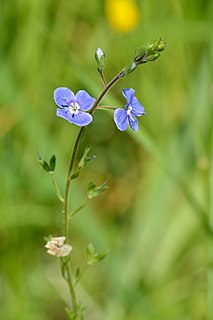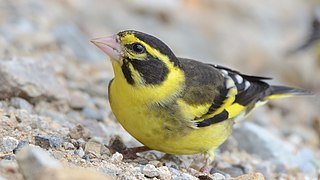
The European greenfinch or simply the greenfinch is a small passerine bird in the finch family Fringillidae.

Cynodon is a genus of plants in the grass family. It is native to warm temperate to tropical regions of the Old World, as well as being cultivated and naturalized in the New World and on many oceanic islands.

The rifleman is a small insectivorous passerine bird that is endemic to New Zealand. It belongs to the family Acanthisittidae, also known as the New Zealand wrens, of which it is one of only two surviving species. The rifleman resembles a wren in form, but is not related to the family of true wrens, Troglodytidae, nor the fairy-wrens of Australia.

Veronica is the largest genus in the flowering plant family Plantaginaceae, with about 500 species. It was formerly classified in the family Scrophulariaceae. Common names include speedwell, bird's eye, and gypsyweed.

Lechenaultia is a genus of flowering plants in the family Goodeniaceae, the species native to Australia with one species also occurring in New Guinea. Plants in the genus Lechenaultia are glabrous shrubs or herbs with needle-shaped leaves, more or less sessile flowers with five sepals and five blue, white, or yellow and red petals in two unequal lobes, the fruit an elongated capsule.

Acacia cambagei, commonly known as gidgee, stinking wattle, stinking gidgee in English, or gidjiirr, by transliteration from indigenous languages of north-western NSW, is an endemic tree of Australia. It is found primarily in semiarid and arid Queensland, but extends into the Northern Territory, South Australia and north-western New South Wales. It can reach up to 12 m in height and can form extensive open woodland communities. The leaves, bark, and litter of A. cambagei produce a characteristic odour, vaguely reminiscent of boiled cabbage, gas or sewage that accounts for the common name of "stinking gidgee".

The collared kingfisher is a medium-sized kingfisher belonging to the subfamily Halcyoninae, the tree kingfishers. It is also known as the white-collared kingfisher, black-masked kingfisher or mangrove kingfisher. It has a wide range extending from the Red Sea across southern Asia to Polynesia. A number of subspecies and subspecies groups have been split from this species including the Pacific kingfisher, the islet kingfisher, the Torresian kingfisher, the Mariana kingfisher, and the Melanesian kingfisher.

The northern pygmy mouse is a species of rodent in the family Cricetidae. It is known as ratón-pigmeo norteño in the Spanish-speaking areas of its range. It is found in Mexico and the United States.

The black-headed greenfinch is a small passerine bird in the family Fringillidae. It is found in the Chinese province of Yunnan, northern Laos, eastern Myanmar and adjacent areas of Vietnam, Thailand and Northeast India. Its natural habitats are subtropical or tropical dry forest and subtropical or tropical dry shrubland.

The yellow-breasted greenfinch is a small passerine bird in the family Fringillidae that is native to the northern regions of the Indian subcontinent.

Chloris is a widespread genus of monophyletic grasses belonging to the family Poaceae, known generally as windmill grass or finger grass. The genus is found worldwide, but especially in the tropical and subtropical regions, and more often in the Southern Hemisphere. The species are variable in morphology, but in general, the plants are less than 0.5 m in height. They bear inflorescences shaped like umbels, with several plumes lined with rows of spikelets. The genus is characterized by the series of sterile florets above the lowest fertile ones, spikes usually 4–10 in numbers, approximated or in a slightly separated series of 10–20 spikes, rarely an indefinite numbers of terminal spikes. In India, 11 species are known to occur in which only two are endemic viz. Chloris wightiana Nees ex Steud. and Chloris bournei Rangachariar & Tadulingam.
Alloteuthis africana, also known as the African squid, is a species of squid in the family Loliginidae. This species of squid is restricted to the Guinean province. To identify the Alloteuthis africana from other Alloteuthis congeners, it is highly recommended to measure the width of the squids head and the sucker size.
4585 Ainonai is a dark Chloris asteroid, approximately 11 kilometers in diameter, located in the central region of the asteroid belt. It was discovered on 16 May 1990, by Japanese amateur astronomers Kin Endate and Kazuro Watanabe at the Kitami Observatory in eastern Hokkaidō, Japan. The presumed carbonaceous C-type asteroid has a longer than average rotation period of 38.3 hours. It was named for the Japanese town of Ainonai, located near the discovering observatory.

Callisia is a genus of flowering plants in the spiderwort family, Commelinaceae. Members of the genus are commonly known as roselings. It is native to the Western Hemisphere from the southern United States to Argentina. The generic name is derived from the Greek word κάλλος (kallos), meaning "beauty."
Daknopholis is a genus of African and Indian Ocean plants in the grass family. The only known species is Daknopholis boivinii, native to Kenya, Tanzania, Mozambique, Aldabra and Madagascar.

Leptochloa is a widespread genus of Asian, African, Australian, and American plants in the grass family.

Cicendia filiformis, also called yellow centaury or slender cicendia, is a species of flowering planet of the family Gentianaceae.

Lupulella is a genus of canine found in Africa. This genus consists of only two extant species, the black-backed jackal and the side-striped jackal.














